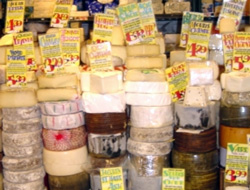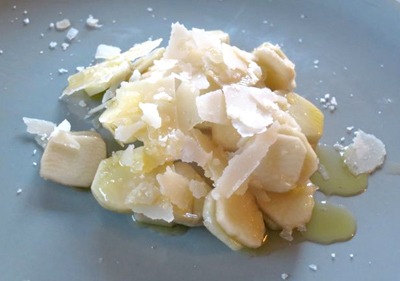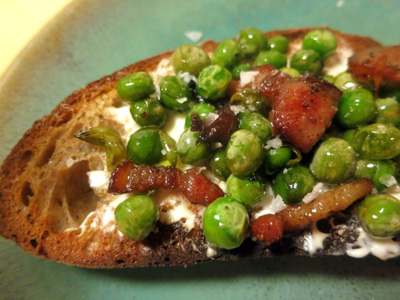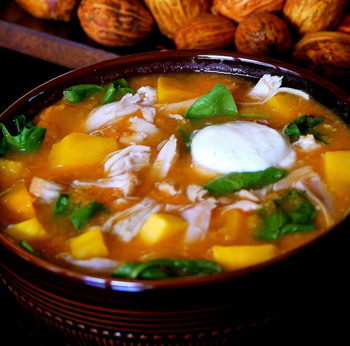 The weather can't seem to decide what it wants to do, in turn making it hard to decide what to eat: something comforting and cheesy or something fresher and green? I decided the only solution was to combine the two.
The weather can't seem to decide what it wants to do, in turn making it hard to decide what to eat: something comforting and cheesy or something fresher and green? I decided the only solution was to combine the two.
One of the great American dishes has got to be macaroni and cheese. Gooey, cheesy and rich with a slight crunch on the top it is pure goodness in a casserole dish. The one problem I have with macaroni and cheese is the guilt. It's soooo rich, it's not the healthiest dish in the world.
One way to make a dish healthier is to cut back on the rich ingredients, like the milk, butter and cheese. Well, that's no fun! I'd rather add in some heathy but tasty stuff as a compromise that really doesn't feel like a compromise at all. My healthy additions are some peas and artichoke hearts, both tasty Spring arrivals. They both go particularly well with gruyere cheese. And gruyere is a perfect cheese for macaroni and cheese.
Spring
Spring
Foxgloves and Delphiniums
 Elegant…purely elegant is the word that comes to mind when I think of foxgloves and delphiniums. Very similar in appearance and growth habit, these two garden goodies are excellent additions the spring tableau and fantastic in arrangements.
Elegant…purely elegant is the word that comes to mind when I think of foxgloves and delphiniums. Very similar in appearance and growth habit, these two garden goodies are excellent additions the spring tableau and fantastic in arrangements.
Digitalis purpurea is the Latin name for foxgloves. The genus Digitalis gathers its name from the ease of which one’s fingers, or digits, can be capped by the floral bells cascading down their stalks. In literary lore, a fox could slip its paws into the bells and use them as gloves - thus the common name. I bet Beatrix Potter had something to do with that. Pinks, creams, lavenders, lilacs, yellows, peaches, and speckled mixes of them all abound in the foxglove color range.
As for other uses besides gorgeous garden elements, the Digitalis genus is used in cardiology to create several types of heart medicine and even some neurological medicines. Quite amazing considering the whole plant, roots, leaves, seeds, and stems are toxic! The pharmaceutical positives are extracted from the leaves…somewhat akin to using snake venom for medicine or a flu vaccination. Don’t worry about the toxicity…just don’t eat them!
A Recipe for Springtime
 According to In Style, shades of gray, scarlet, and yellow are hot this spring. I, however, prefer green and purple, as in fresh English pea green and baby artichoke purple. Apparently, so do San Diego's farmers; our farmers' markets have some of the most stylish looking artichokes around – ranging from petite purple baby artichokes to hefty, celery green Big Heart artichokes.
According to In Style, shades of gray, scarlet, and yellow are hot this spring. I, however, prefer green and purple, as in fresh English pea green and baby artichoke purple. Apparently, so do San Diego's farmers; our farmers' markets have some of the most stylish looking artichokes around – ranging from petite purple baby artichokes to hefty, celery green Big Heart artichokes.
Despite their diminutive size, baby artichokes are fully mature artichokes with a full-bodied, earthy flavor. They simply don't grow as large as Globe or Big Heart artichokes because they're picked from the lower part of the artichoke plant. As a result, the characteristic fuzzy choke isn't all that fuzzy and can be eaten. Indeed, other than a few tough outer leaves, the entire artichoke is edible.
Baby artichokes are delicious in many dishes ranging from risotto and pasta to salads and soups. Paired with Italian Farro or emmer, as in this Farro with Baby Artichokes, Mushrooms, and Peas, baby artichokes are exceptionally stylish.
Artichokes: Don’t Forget the Stems
 People say we don’t have seasons in LA. Oh but we do my friends, we do. For example, now is Artichoke Season, a time when (if you’re lucky) you can find a farmer harvesting huge heavy artichokes with a long stem still attached. The artichoke head that we eat is the bud stage of a giant gorgeous purple flower. As the artichoke ages the “leaves” of the bud open ultimately revealing the choke which turns deep lavender. For eating you want the bud pretty tightly closed. And look for heavy artichokes. Heaviness means freshness. When the artichoke is freshly cut it’s cells are full of water. As time goes by the water transpires and evaporates leaving the vegetable light and dry.
People say we don’t have seasons in LA. Oh but we do my friends, we do. For example, now is Artichoke Season, a time when (if you’re lucky) you can find a farmer harvesting huge heavy artichokes with a long stem still attached. The artichoke head that we eat is the bud stage of a giant gorgeous purple flower. As the artichoke ages the “leaves” of the bud open ultimately revealing the choke which turns deep lavender. For eating you want the bud pretty tightly closed. And look for heavy artichokes. Heaviness means freshness. When the artichoke is freshly cut it’s cells are full of water. As time goes by the water transpires and evaporates leaving the vegetable light and dry.
You can use the artichoke heads as you wish: boiled, steamed, stuffed, trimmed and braised, hearts only. But don’t throw away the stems. If I’m feeling selfish I simply peel away the fibrous outer portion and munch the tender, crunchy, sweet and nutty inner stem. If I want to impress then I make this artichoke stem salad. You get one small portion for each stem. So it’s fun to have a two course meal. First, a pretty plated salad, then one big beautiful artichoke each to pluck, dip then scrape with your teeth.
Peas on Toast with Bacon
 It was one of those days. I had run all over town doing errands when suddenly it was 5 o’clock and I remembered that the fridge was uncharacteristically empty. I got home, ran up the stairs, ran into the kitchen slightly panicked (the Mom must be fed) and saw that the Farmers Market Fairy had come. Really. That’s what Linda calls herself. And in that moment I could have kissed her.
It was one of those days. I had run all over town doing errands when suddenly it was 5 o’clock and I remembered that the fridge was uncharacteristically empty. I got home, ran up the stairs, ran into the kitchen slightly panicked (the Mom must be fed) and saw that the Farmers Market Fairy had come. Really. That’s what Linda calls herself. And in that moment I could have kissed her.
For years I had to be in the studio at KCRW every Wednesday morning for interviews so that meant I missed the Santa Monica market every week. Until Linda came into my life and started shopping for me. Now she’s my biggest luxury. Sitting on my counter were fresh strawberries, kumquats, spigariello, spinach, green garlic, CHERRIES!, Roan Mills bread and peas. Shelled peas, no less.
More Articles ...
Welcome to the new One for the Table ...
Our Home Page will be different each time you arrive.
We're sure you'll find something to pique your interest...

